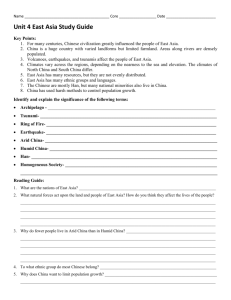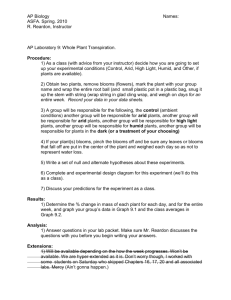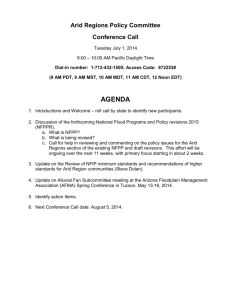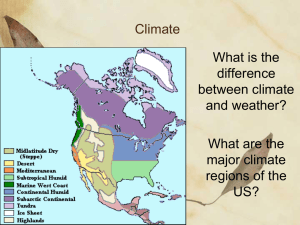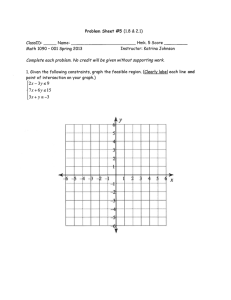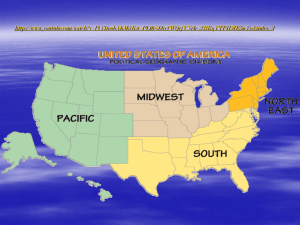An Examination of the Most Recent Economic Cycle from an... By Daniel Kuester* and Charles R. Britton*
advertisement
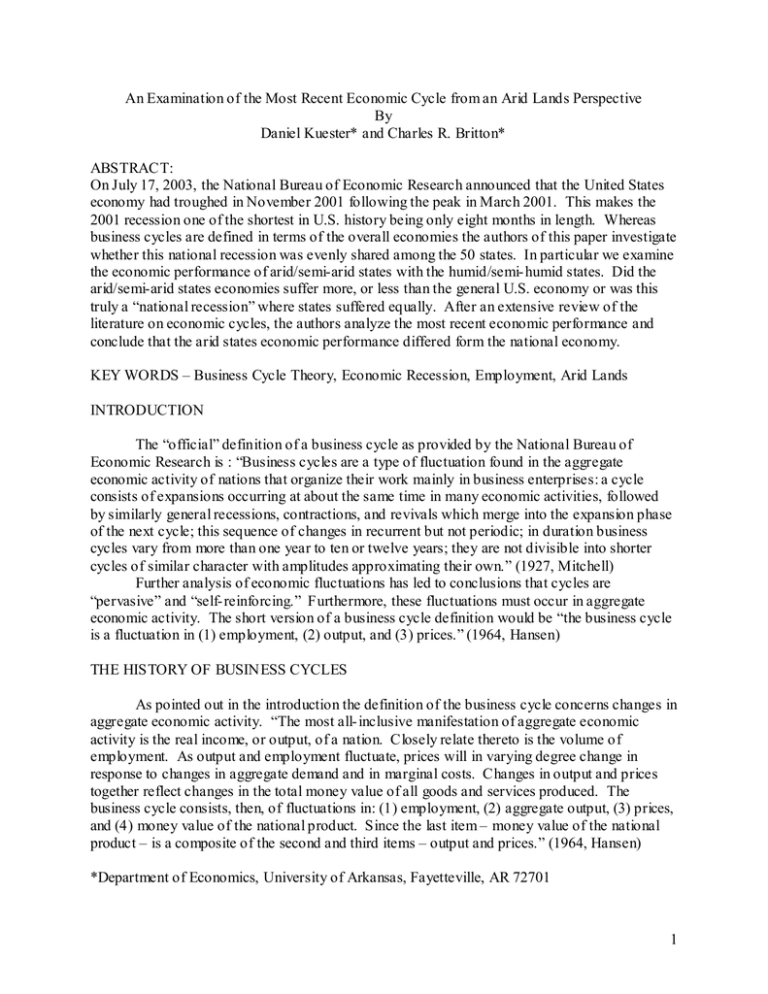
An Examination of the Most Recent Economic Cycle from an Arid Lands Perspective By Daniel Kuester* and Charles R. Britton* ABSTRACT: On July 17, 2003, the National Bureau of Economic Research announced that the United States economy had troughed in November 2001 following the peak in March 2001. This makes the 2001 recession one of the shortest in U.S. history being only eight months in length. Whereas business cycles are defined in terms of the overall economies the authors of this paper investigate whether this national recession was evenly shared among the 50 states. In particular we examine the economic performance of arid/semi-arid states with the humid/semi- humid states. Did the arid/semi-arid states economies suffer more, or less than the general U.S. economy or was this truly a “national recession” where states suffered equally. After an extensive review of the literature on economic cycles, the authors analyze the most recent economic performance and conclude that the arid states economic performance differed form the national economy. KEY WORDS – Business Cycle Theory, Economic Recession, Employment, Arid Lands INTRODUCTION The “official” definition of a business cycle as provided by the National Bureau of Economic Research is : “Business cycles are a type of fluctuation found in the aggregate economic activity of nations that organize their work mainly in business enterprises: a cycle consists of expansions occurring at about the same time in many economic activities, followed by similarly general recessions, contractions, and revivals which merge into the expansion phase of the next cycle; this sequence of changes in recurrent but not periodic; in duration business cycles vary from more than one year to ten or twelve years; they are not divisible into shorter cycles of similar character with amplitudes approximating their own.” (1927, Mitchell) Further analysis of economic fluctuations has led to conclusions that cycles are “pervasive” and “self- reinforcing.” Furthermore, these fluctuations must occur in aggregate economic activity. The short version of a business cycle definition would be “the business cycle is a fluctuation in (1) employment, (2) output, and (3) prices.” (1964, Hansen) THE HISTORY OF BUSINESS CYCLES As pointed out in the introduction the definition of the business cycle concerns changes in aggregate economic activity. “The most all- inclusive manifestation of aggregate economic activity is the real income, or output, of a nation. Closely relate thereto is the volume of employment. As output and employment fluctuate, prices will in varying degree change in response to changes in aggregate demand and in marginal costs. Changes in output and prices together reflect changes in the total money value of all goods and services produced. The business cycle consists, then, of fluctuations in: (1) employment, (2) aggregate output, (3) prices, and (4) money value of the national product. Since the last item – money value of the national product – is a composite of the second and third items – output and prices.” (1964, Hansen) *Department of Economics, University of Arkansas, Fayetteville, AR 72701 1 Today economists study many different potential causes for fluctuations in aggregate economic activity. The primary theories for the causes of business cycles focus either on 1) aggregate demand concerns such as overinvestment or underconsumption or on 2) aggregate supply concerns such as technological change or a shift in the resources available to a nation. Obviously a combination of the above causes for business cycles may be considered as well. Historically, the study of business cycles has developed slowly and inconsistently during the last two centuries. The study of business cycles did advance tremendously during the twentieth century. Many economists were quick to adopt classical economic thought prior to this time and subscribe to Say’s Law which states that “supply creates its own demand”. These economists dismissed the existence of insufficient aggregate demand and employment and therefore did not concern themselves with studying aggregate economic activity in a nation. The overall economy was self regulating at a full employment level. Different economists have devoted considerable time and effort to the study of cycles and their causes. One of the earliest economists to acknowledge the existence of cyclical economic phenomenon was Thomas Robert Malthus. Malthus was the first to discuss underconsumption and a lack of aggregate demand as a potential cause of a recession. Malthus did not subscribe to Say’s Law as the other economists of his time did. Malthus understood that output as well as prices could fluctuate dramatically. “It is frequently stated in the ‘Wealth of Nations’ that a great demand is followed by a great supply, a great scarcity by a great plenty, an unusual dearness by an unusual cheapness. A great and indefinite demand is indeed generally found to produce a supply more than proportioned to it. This supply as naturally occasional cheapness; but this cheapness, when it comes must in its turn check the production of the commodity, and this check upon the same principle is apt to continue longer than necessary and again to occasion a return to high prices.” (Malthus, 1872 p. 350) Other economists did acknowledge the existence of business cycles and recessions even when most economists dismissed their existence. Karl Marx assumed that a capitalist society would undergo a type of “cycle” which would lead to more and more severe depressions until capitalism would doom itself. John Maynard Keynes became famous for his advancements in Malthus’ discussion of inadequate aggregate demand. The publication of the General Theory of Employment, Interest, and Money (1936) led economists to fully consider the existence of insufficient aggregate demand and therefore potential concerns with business cycles. William Stanley Jevons’ (1909) “sunspot” theory of business cycles focused on the relationship between weather patterns and overall output in an economy. While agricultural output would be the most directly affected by weather patterns the linkages that exist between agricultural output and industrial output were strong enough that overall productivity in the economy could closely follow periods of relative plenty and scarcity in agricultural production. Jevons (and his son in later works) discovered that an approximately eleven year business cycle in England appeared to exist and closely follow agricultural trends. Jevons’ empirical work was important because he discussed the potential existence of economic activity potentially peaking and troughing every eleven years at a time that was not commonly being studied. Jevons also considered that psychological factors could influence aggregate consumer demand in the English 2 economy. “From the sun which is truly ‘of this great world both eye and soul’ we derive our strength and our weakness, our success and our failure, our elation in commercial mania, and our despondency and ruin in commercial collapse.” (Jevons, 1909 d, p. 235) It is our belief that this relationship between agricultural output and overall prosperity is consistent with marked differences in economic recovery between humid/semi humid areas and arid/semi arid areas. (Britton and Kuester, 2003) MODERN BUSINESS CYCLE THEORY The most important contributions to business cycle study in the last century were made by Wesley C. Mitchell and by Joseph Schumpeter. Mitchell, who founded the National Bureau of Economic Research, primarily contributed to the empirical study of business cycles and felt that advancements in empirical study would lead to improved understanding of business cycles. “For the problems of economics have in part been formulated primarily by men who were using an introspective type of method and they were formulated in ways which are open to attack of that type of method. If the theorist changes his method form the introspective to the objective type, if he tries to rely so far as possible upon the analysis of mass observation, then in many cases he much reformulate the problem before he gets it in shape for attack.” (Mitchell, 1969 from Oser and Blanchfield, 1975 p. 392) Mitchell was one of the first to identify the existence of business cycles and provide empirical data explaining when they occurred. His Business Cycles and their Causes (1913) was a serious treatment of a topic that had not received much consideration in the past. Mitchell explicitly discussed the tendency for economies to decline, reach a trough and then recover and expand. Mitchell’s felt that depression and more severe business cycles were more likely in a society like the United States where luxury goods and durable goods were readily available. People could delay consumption of these goods when the economic outlook was not promising. Psychological factors in potential economic growth were inherent in Mitchell’s discussion. Mitchell believed that expansions were caused by the existence of anticipated future profits which increased investment and economic activity. When there was overinvestment in a market or credit was not readily attainable because future expected profits were exhausted, this would lead to an economic slowdown. Mitchell believed that the availability of credit was extremely important in stimulating an economic recovery or in potentially stifling economic growth. He felt that this availability of credit combined with some cause for optimism would lead to recovery from recession. Mitchell was first to describe in detail a natural cycle of economic downturns and expansions because of this. “We have then a situation in which a very rapid increase in business transaction is easy physically; resources of various types are not being used to anything like capacity… And business enterprises, if not individuals, are in a position to buy on a large scale when it seems worth while. The obstacles to setting the wheels vigorously in motion again are altogether of an economic sort. Not only is it physically possible to do a larger volume of business, but everybody is eager to do it. Of course the man on the street is most eager as a rule to get a job, but he is 3 scarcely less eager than the man who has an idle factory is to set it working again. And for that matter the banks are scarcely less eager than the manufacturers or the workingmen to be operating again to the extent that their means justify so that their profits may get back to a satisfactory level… Well, now those economic obstacles to a resumption of activity consist in grave and well founded doubts about the profitableness of buying more freely. And the reason why people doubt the profitableness of operating more freely is that they doubt the possibility of selling more freely. Well, we know that at the end of every period of depression in the past the time has come when these economic obstacles, these fears about getting an adequate market, have been overcome. (Mitchell, p. 63, 1927) Mitchell described business cycles as being widely distributed throughout the economy. Many industries are interdependent on one another and prosperity in one industry will directly affect another industry. However, certain industries will have more profit potential than others and those industries would have more volatile cycles than other industries. It would stand to reason that the agricultural sector of the economy and presently the service industry would experience less dramatic cyclical behavior than more urban areas particularly those with significant manufacturing output. This might imply that arid/semi arid lands would experience smaller fluctuations in output during a particular recession if that slowdown wasn’t focused on some specific industries. STAGES OF BUSINESS CYCLES Joseph Schumpeter explicitly defined the four stages of a business cycle in Business Cycles (1939). Every economy had a natural tendency to expand and then peak followed by recession and finally a bottoming out or a trough. Schumpeter actually described three different business cycles one long (around fifty years), one of intermediate length (seven to eleven years) and one of shorter length (forty months). Schumpeter described the Great Depression as occurring at the odd and unfortunate time where all three of these business cycles were at their minimum at the same time. Schumpeter provided empirical evidence to justify his claims in Business Cycles as well as his theoretical construct. Schumpeter believed that the primary cause of business cycles or changes in a capitalist economy occurred due to innovation. Schumpeter further understood the importance of psychological attitudes and supply shocks such as technological change and war but focused on the innovator as the key to economic activity. According to Schumpeter; when innovation occurred it would move the economy from a steady state. The inevitable swarm of copies of the innovation would lead to a rash of borrowing and investment spending creating a boom period. Eventually, prices would be forced down due to the increased costs of production by competition leading to disappearing profits and declines in investment with the inevitable contraction. This process of disturbing the steady state was accomplished by the innovator or entrepreneur and called “creative destruction”. Innovation would lead to increased profits in the industry it occurred in and in the areas that industry was primarily located. When innovation took place in technologically based manufacturing industries most of the boom and subsequent decline took place in urban areas. 4 This is similar to our comparison of the recent arid/semi arid lands response to the recession of 2001. Areas with different geographical characteristics and different industry structures have always responded in different ways to economic expansions and contractions. (Britton and Kuester, 2003) RECENT ECONOMIC PERFORMANCE “The U.S. business expansion that started in March 1991 and ended exactly a decade later lasted more than a year longer than the previous record – long 1961-69 expansion.” (2003, Kliesen) On July 17, 2003 the National Bureau of Economic Research announced that the United States economy had its peak in March 2001 and the corresponding trough in November 2001 making it one of the shortest recessions in U.S. history being only eight months in length. The shortest down turn was six months in 1980 and the average contraction has been eleven months. The 2001 contraction was both short and shallow and bears a lot of commonality with the July 1990 to March 1991 recession. Both these recessions followed exceedingly long expansions (120 months = longest and 92 months = third longest) respectively. The most noticeable resemblance between the two recessions is that they led to relative “mild” recoveries with the major concern being a lack of recovery in employment in the most recent recovery. This is of concern to economists but also to politicians with a national election due in 2004. “The irony, of course, is that the original ‘jobless recovery’ (1990-92) has already been replaced by another, more pronounced one.” (2004, Federal Reserve Bank of Cleveland) Another term for the current “jobless recovery” is the “concept of a ‘stealth recovery’. Basically, what this means is that while gross domestic product grew in all four quarters of 2002, the uneven performance of the U.S. economy last year didn’t make many people feel like we were steadily recovering from the recession that began in 2001. That’s because a number of the economic developments that we typically associate with a recovery didn’t occur.” (2003, Guynn) Another report states: “the U.S. economy has been expanding for the past two years, yet, when one looks back over this period, it feels like the economy has continued to struggle and has not performed as well as it should. In fact, while output rose in each of the past eight quarters, employment declined in all but one of them.” (2004, Federal Reserve Bank of Chicago) The authors of this paper wish to address the perception that the business cycles are pervasive i.e. apply to all castors of the economy and all sectors of the nation. To do this we analyze the “jobless recovery” as it applies to the arid/semi-arid state versus the rest of the United States. First, we examine the payroll employment data for the individual states and then look to see if arid/semi-arid states suffered the recession (March 2001 to November 2001) differently than the U.S. in general. Next, we analyze the economic recovery of arid/semi-arid states versus humid/semi- humid states (November 2001 to current – December 2003). Another way of stating this is to ask “whether the recent recession was a truly ’national’ event, or whether it instead was localized in just a few geographic areas.” (2003, Federal Reserve Bank of St. Louis) EMPLOYMENT – MARCH, 2001 – DECEMBER 2003 Table 1 provides the data for payroll employment for the individual state for two time periods. The first time period is for March 2001 to November 2001 (the most recent recession 5 according to NBER) and secondly for the most recent recovery period (November 2001 to current – December, 2003). The data is non-seasonally adjusted to provide a greater detail in employment changes for the two periods. Also provided in Table 1 are the percent changes in employment for the two periods. The most important thing to notice is that during the recession most states experienced a growth (not loss) in employment. In other words, aggregate output may have declined but there was no corresponding decline in employment. It truly was a “mild” recession. Table 2 provides more in depth data. Only fourteen states suffered an actual decline in employment during the recession while most experienced a growth in payroll employment during this economic down turn. The arid/semi-arid states are identified. A cursory glance seems to indicate they were less adversely affected by the recession versus the humid/semihumid states. Most detailed analysis will be provided later. Table 3 provides the non-seasonally adjusted payroll employment data for individual states for the current economic expansion (November 2001 to December 2003). It is worth noting that fifteen states suffered employment losses during this greater than the states suffering losses during the recession. Once more a cursory glance indicates the arid/semi-arid states had greater employment gains during the recovery. AN ARID/SEMI-ARID – HUMID/SEMI-HUMID COMPARISON A comparison of the economic performance of the arid/semi-arid states versus humid/semi- humid states is provided in Table 4. The states are ranked according to their relative changes during the recession and recent recovery. Certain observations are obvious. First, the arid/semi-arid had an average rank of 18.5 with respect to employment performance during the recession. Referring back to Table 2 reveals that only one arid/semi-arid state had negative employment change during the down turn (Montana), while the other thirteen states had employment gains even during the recession. The average ranking for the humid/semi- humid states was 28.2 for the recession which was much higher than the arid/semi-arid states (18.5). It should be noted that the states were ranked 1 through 50 which produces a mean value of 25.5. The employment behavior for the individual states was just as revealing for the current recovery (November 2001 to December 2003). Table 4 provides the data for the recovery period for the individual states as well. That states are once again ranked from high to low for performance. With respect to employment growth the arid/semi-arid states had an average rank of 21.1 while the humid/semi- humid states witnessed a ranking of 27.2. Obviously the arid/semi-arid states exhibited a much better ranking with respect to actual employment growth during a general economic downturn and greater employment growth during the economic expansion. It would appear that the “jobless recovery” does not apply to the arid/semi-arid states but instead may be more isolated in the humid/semi- humid states. CONCLUSIONS Table 5 and Table 6 provide a summary of the employment performance for the arid/semi-arid states versus humid/semi- humid states. The peak (March 2001) to trough (November 2001) payroll employment data is analyzed in Table 5. The states were first ranked according to employment changes. The states in the top 25 were compared with the bottom 25 6 states which exhibited the “best” performance during the recession (had actual employment gains during the downturn) ten of them were arid/semi-arid while the other fifteen were humid/semihumid states. Further, of the 25 states suffering the worst employment performance during the recent recession only four were arid/semi-arid states and twenty-one were humid/semi- humid states. Greater detail is provided by looking at the percentages. There are fourteen sates identified as arid/semi-arid states and thirty-six classified as humid/semi- humid states. Table 5 is once more very revealing. The arid/semi-arid states constituted ten of the best employment performance states. But, this is 40 % of the total states in this category. The most telling statistic is that 71 % of the arid/semi-arid states fell into the best performance category. Obvious, the humid/semi- humid states suffered to a greater degree during the recession. They comprised 84 % of the worst performing states (versus 16% for arid/semi-arid states). It is obvious that the arid/semi-arid states did not suffer the same employment problems during the recession. The recent economic recovery period (November 2001 to December 2003) exhibits similar patterns as can be seen in Table 6. Once more the states were ranked into two categories – those that had the best performance during the time period and those that did not. Of those states exhibiting the greatest growth, nine (36%) were identified as arid/semi- arid and 16 (64%) were humid/semi- humid. Of the worst performing states, five (20%) were arid/semi- arid states and twenty (80%) were humid/semi- humid. What is more important once again, is that 64% of the arid/semi- arid states fell into the best performance category and only 5 or 36% were in the worst performance category. Less than half (44%) of the humid/semi- humid states were in the best performance classification while 56% were in the worst category. SUMMARY The term “jobless recovery” does not seem to apply to the arid/semi-arid states. First, as seen by the payroll employment data these states did not suffer significant declines in employment during the recession (only Montana had negative employment changes). Secondly, during the recent recovery the arid/semi-arid states also exhibited more growth in employment than the humid-semi/humid states. The recent recession (March 2001 to November 2001) did not adversely impact the arid/semi-arid states to the same degree as the overall U.S. economy. Furthermore, the “jobless recovery” of the current expansion is more applicable to the humid/semi- humid states since the arid/semi-arid states have exhibited greater employment growth. 7 REFERENCES Britton, Charles R. and Kuester, Daniel – “A Re-examination of the Sunspot-Weather – Theory of Business Cycles”, Forum of the Association for Arid Land Studies, International Center for Arid and Semi-arid Land Studies, Texas Tech University, Lubbock TX Vol. XIX No 1, 2003. Crone, Theodore M., 2003. “The Long and the Short of It: Recent Trends and Cycles in the Third District States” Business Review. Third Quarter Federal Reserve Bank of Philadelphia. pp 29-37. Federal Reserve Bank of Chicago, 2004. “Expansion Picks Up Steam” Chicago Fed Letter, February No. 199a. Federal Reserve Bank of Cleveland, 2004. “The Economy in Perspective,” Economic Trends, February. p.1. Federal Reserve Bank of St. Louis, 2003. “A National Recession,” National Economic Trends, April p.1. Guynn, Jack, 2003. “What’s Different About This Recovery?” EconSouth. First Quarter Federal Reserve Bank of Atlanta. p.1. Hansen, Alvin H. 1964. Business Cycles and Nation Income. New York: W.W. Norton& Co. Jevons, William Stanley, 1909a. Chapter VI, “The Solar Period and the Price of Corn (1875)”, Investigations in Currency and Finance. London: Macmillan, pp. 194205. Jevons, William Stanley, 1909b. Chapter VII “The Periodicity of Commercial Crises and Its Physical Explanation (1878), with Postscript (1882)”, Investigations in Currency and Finance. London: Macmillan, pp 206 – 220. Jevons, William Stanley, 1909c. Chapter VII “Commercial Crises and Sunspots Part I (1878)”, Investigations in Currency and Finance. London: Macmillan, pp 221234. Jevons, William Stanley, 1909 d. Chapter VII “Commercial Crises and Sunspots Part II (1879)”, Investigations in Currency and Finance. London: Macmillan, pp 235243. Keynes, John Maynard, 1936. The General Theory of Employment, Interest, and Money. New York: Harcourt Brace Jovanovich. 8 Kliesen, Kevin L. 2003. “The 2001 Recession: How Was It Different and What Developments May Have Caused it” Review. Federal Reserve Bank of St. Louis. Vol. 58. No 5 pp 23-38. Kliesen, Kevin L. 2004. “The Economy Gets Back on Track but Not Jobs” The Regional Economist. Federal Reserve Bank of St. Louis. January, pp 4-9. Malthus, Thomas Robert. (1872) An Essay on the Principle of Population. London. Reeves and Turner, 7th ed. Augustus M. Kelley, 1986. Mitchell, Wesley. Business Cycles and Their Causes, Berkeley Cal: University of California Press 1941, Originally Published in 1913. Osner, Jacob and Blanchfield, William C. 1975. Economics: Reality Through Theory. New York: Harcourt Brace Jovanovich. Schreft, Stacey L. and Singh, Aarti. 2003. “A Closer Look at Jobless Recoveries” Economic Review, Second Quarter. Federal Reserve Bank of Kansas City. Vol. 88 No. 2 pp. 4573. 9
